There is something surreal about sitting centre stage in a bar in Siberia at 6am eating a breakfast of Frankfurters and fried eggs as nubile Russian starlets twerk to the latest inane pop hits on a giant TV screen.
The staff and owner line up along the counter, watching several haggard Western Europeans figure out whether the grey gristle that fills a plate of pancakes is animal, vegetable or mineral.
After struggling to cope with the Beast from the East earlier this month, we have tracked it to its lair, where temperatures can fall as low as -50 degrees Celsius.
0 of 4
In the frozen darkness of a Siberian morning, the flickering disco lights and those of the karaoke bar across the road symbolise the frontier character of Irkutsk.
The city was once billed as “the Paris of Siberia” by someone who had never been within an ass’s roar of the French capital. Irkutsk is a hodge-podge of ugly post-communist cement and sinking wooden shanty houses. In between is the hateful Soviet-era architecture that fills the soul with gloom.
But we're not here to admire its beauty, we're here to cross neighbouring Lake Baikal, the world's largest freshwater lake by volume, home to 23 per cent of the planet's fresh surface water. Maximum depth is over 1.6 km, so it's also the world's deepest lake. And we're crossing it in a mid-sized Mazda crossover.
The lake boasts several benchmarks, including as the world’s oldest lake at 25 million years. It’s home to a multitude of species unique to this location. One of these is the omul fish, a staple in every local dish.
Seismic front
Thankfully, for our driving plan, Baikal freezes hard in the winter to a depth of over one metre of ice. Unfortunately for us, as the spring approaches cracks open and streak for up to 30km across the ice. To add to the thrills and increase the risk of spills, every few months Baikal shakes. It’s active on the seismic front.
Russians are famed for their hardiness and stoicism in the face of adversity. Around here they need to be.
The people of Irkutsk know this better than most. A former garrison town tasked with keeping the neighbouring Buryats in check – and an eye on the neighbours to the south – it was also the main town for the surrounding prison camps where exiles were sent.
According to notices in the local museum, the 19th century saw a million convicts marched from the western regions into the Siberian wild, many with their families in tow.
Invariably they made it from labour camp and mines to the town. Adding culture to the mix was the exiled elite who led the failed Decembrist revolt of 1825. All this in a remote frozen wasteland 5,500km from its Moscow-based rulers. It's hardly surprising that it earned the infamous title as the murder capital of Russia.
Needless to say, in a frontier town so far away, reports of nerve gas attacks on former spies based in the UK elicits little more than a shrug. One Russian woman, through broken English, says: “We will not know the truth.”
Widen the chat to the presidential election and the recurring message among the very few Russians willing to talk politics with us is that Putin brings order where before there was chaos and criminality.
Epiphany
Quickly talk returns back to Baikal and the all-pervasive omul fish.
Someone in Mazda clearly had an epiphany about an epic test drive after hitting the vodka and omul hard, and came up with the grand plan to drive the new CX-5 – all-wheel drive versions, let’s not be silly here – across a frozen Baikal.

Certainly the postcard images look enchanting, with the ice glistening in the winter sun and the translucent surface showing the clear water underneath.
As with all things in Siberia, reality bites. The snow is ankle deep as we head towards the mouth of the Angara River, the only river that flows out of the lake.
Alex, a stocky Russian sailing champion who could double as a hipster surfer, is our guide across the frozen ice. His windswept perma-tan suggests a life more acquainted with trimming sails than shovelling snow but he is devoted to the waters of Baikal.
Before we head on to the ice he rattles off the usual safety briefing before ending on a rather ominous note. “On average one car a year goes through the ice.” Don’t wear seatbelts, keep the doors unlocked and we should be fine. If we do go in, we’ll have two minutes before the car sinks. Plenty of time to react, he reassures us.
It’s actually illegal to drive on the ice without permission and it seems to be the one rule Russian drivers respect. So at least we won’t have to worry about traffic.
At 8.30am we drive on to the ice. Beneath our tyres is a light layer of snow, about 8cm deep and under it a layer of ice that we hope is about one metre thick. Heading up our convoy of a dozen Mazdas is the ultimate off-roader. Forget your rugged 4x4. Looking like a lunar landing buggy, the Trekol 39294 is a 6x6 amphibious monster truck.
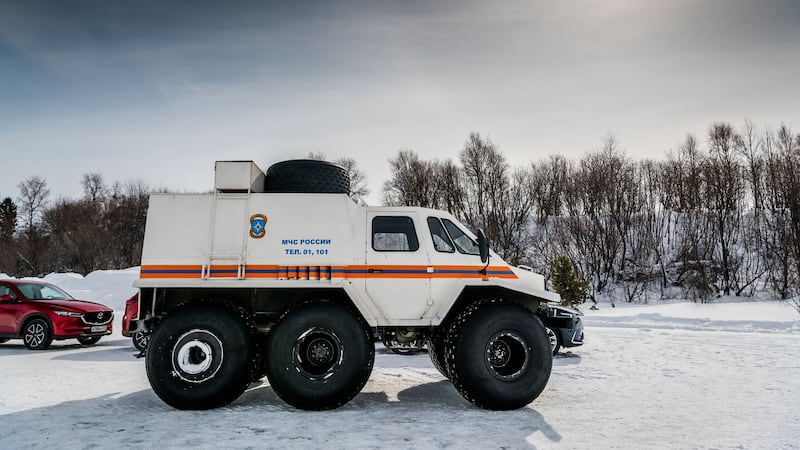
Tyre trails
Russian to its core, it stands nearly three metres tall, but weighs in at under three tonnes thanks to a fibre glass body panels. Despite its size and six powered wheels, it leaves the lightest of tyre trails, while our little CX-5s dig trenches through the snow. The plan is that it will lead the way, leaving us to follow its lightly treaded tracks.
The route across has had to be adjusted because of cracks in the ice. For once we hope for a big freeze, but it’s a relatively balmy -6 degrees on the day.
What should have been a 40km straight shoot across the lake is now going to see us heading north-east, bringing our total distance across the frozen lake to over 60km. Estimates are that it will take four hours. The Beast from the East has other plans.
As we hug the western coast we pass a small port of fishing boats, frozen solid in the ice. It’s comforting to have the coast in sight. Three hours in and still with the western shore, occasionally visible between the blizzards, realisation starts to set in that we should really be further west.
Every now and then the Trekol disappears ahead, while the lake’s violent winds blow snow over its tracks. Radio calls for it to stop and return, to either pull a CX-5 from a snowdrift or simply show us the way, are regular and frequent.
The risk is not just that the ice might crack, it’s the large hidden shards cloaked in snow; hitting these is like running into a brick wall. Even crossing what looks like a manageable pile of snow can be treacherous. At first, it’s relatively square and solid but the drop on the other side bottoms out the suspension with a crash.
Convoy
When cars do get stuck the convoy of a dozen Mazdas comes to a halt. And this leads to further problems. The cars are bunching up too close, as if huddling for comfort and reassurance as visibility fades. The radio crackles with a warning that too many cars parked too close could be too much weight on a single area of ice. Next time we stop, drivers keep their distances.
Then comes the crack. A large seismic-like crevice stretches into the horizon on either side. This is where the two ice plates that grew from each shore meet up and rub together. It’s only about three metres wide in parts, and it does seem to have a covering of ice, though lighter and more slushy perhaps.
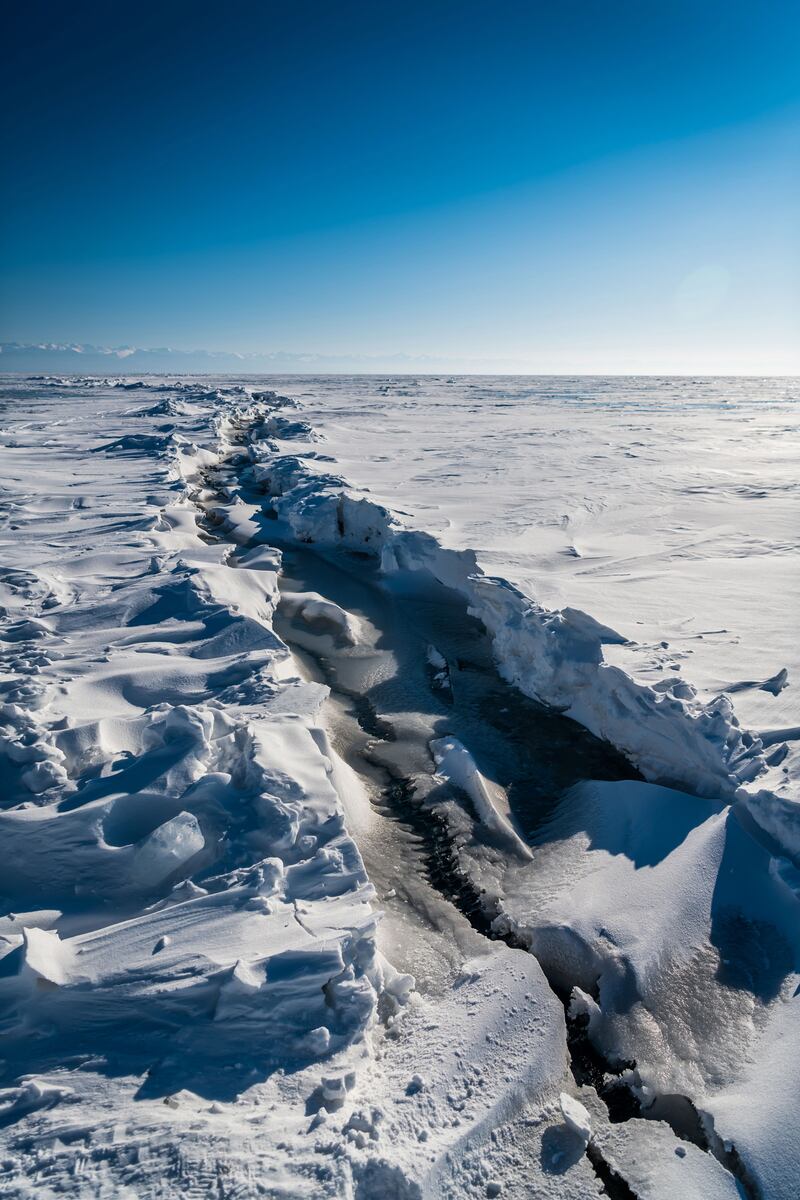
If you could get a good run at it you might just make it over. Then again, on the ice you would be on your ass before the second stride of your run up. As for trundling over it in a CX-5, that would merely send another car and an idiot to the murky bottom of Baikal.
The Trekol and its Russian crew drive off to find the smallest gap. They then lead us to a point where they reckon we could cross, courtesy of a makeshift bridge. They build up some snow on the crack’s thin layer of ice, then lay down a plastic cover. They then screw together some random bits of timber to create two towpaths wide enough for the Mazda’s tyres.

From outside, supervising operations, Alex offers a friendly word of advice before we make the crossing. “Floor it, full throttle and don’t stop.” It’s a pity because I was planning on parking up halfway across to admire the view.
Whiteouts
We’ve been on the ice over three hours now and we’re not even halfway across. The problem is the wind whips up regular violent blizzards and whiteouts. So every 200 metres the lead or second car gets stuck. It becomes routine. And in the snaking s-shapes trail we are making through the snow it seems like we are working hard to get nowhere.
Then, at 2.48pm – over six hours after gingerly driving on to the ice and two hours later than planned – we spot the a grey outline of the eastern shore. At first, my colleague in the car, David Bannon of Mazda Ireland, dismisses it as a mirage. But ever so slowly a shimmering grey outline emerges from the white haze. The end is near. Yet it takes another hour to get to shore.
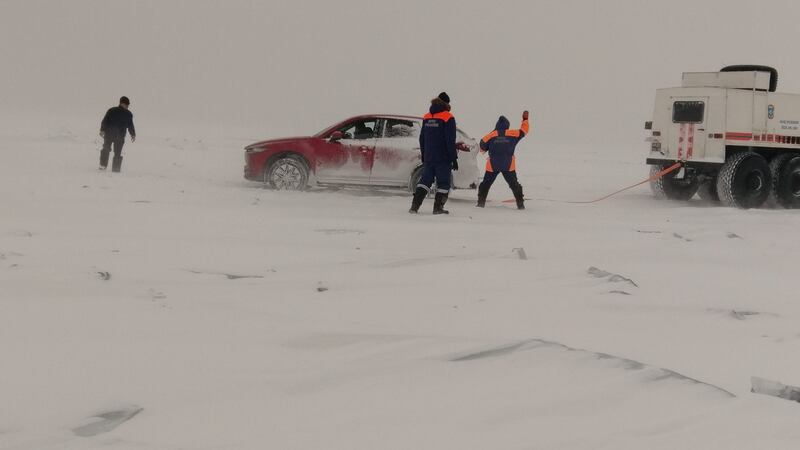
Four hours later than planned and frozen solid, we drive up the ramp of a tiny jetty in the town of Kluyevka, much to the bemusement of a local lady out walking her two dogs. She wasn’t expecting us. Then again, we weren’t expecting to be here.
But the good news is that we are back on the public roads. Not that the driving conditions have dramatically improved. The M55 is a potted and rotted highway that runs around Baikal’s southern rim.
It’s part of the famous Trans-Siberian Highway, connecting east and west, most of the time running alongside its namesake railway, the longest train connection in the world.
It’s the main – in parts only – road connecting Russia’s sparsely populated Pacific rim to the populous west. Given its importance and the economic traffic that travels along, the term highway might be misleading. It’s one lane either way, about the width of your average Irish national road.
Pitstop
Trucks tear past at full pelt on the partially gritted road. Every so often we come across a car or truck that has slid down into the ditch, its occupants waiting for the vehicle to be dug out. In one case there’s a large flatbed with a digger on the back.
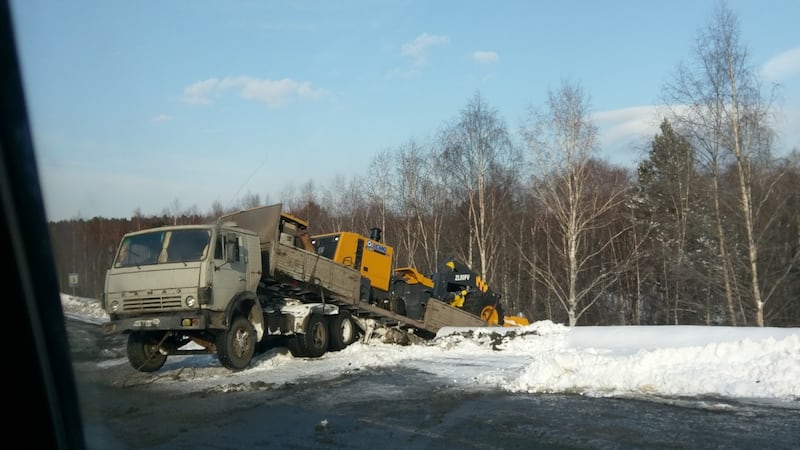
Eight hours on the lake requires a quick pitstop in the nearby town of Babushkin. We pull up next to a beaten-up right-hand drive Japanese import. A couple sit in the front seat watching an old portable TV sitting on the dash. The car is fitted with curtains. It’s hard to tell if this is a brief halt in their trip, or their house.
At one end of the building is a door, seemingly to the toilets. Behind it is a small sittingroom-cum-office where a smiling elderly lady is watching a Russian soap opera blaring from an old colour TV. This is the frontline of post-communist enterprise.
To her right are three urinals and a line of squat toilet holes behind saloon-style swing doors. It is 15 roubles (20 cent) to use the facilities.
The restaurant is a time capsule from the 1970s. Food and drinks are displayed on the shelves with handwritten prices sellotaped to the front. Pride of place in a glass display case goes to a Bounty bar of uncertain vintage.
But whatever hunger we had after eight hours on the ice vanishes with the first whiff from the cafe kitchen. It’s an overpowering mix of pickled vinegar, boiled cabbage and floor detergent.
Back on the road and as we move towards Ulan Ude, capital of Buryati, the skies clear to offer up a glorious sunset and, despite the car’s thermometer reading -8 degrees, the snow clears to show tarmac. Tiny wooden houses huddle together by the side of the road.
The smoke stacks are the first signs of the city. Its proudest boast is as home to the largest cement head of Lenin on the planet. Someone had to have it, so why not Ulan Ude.
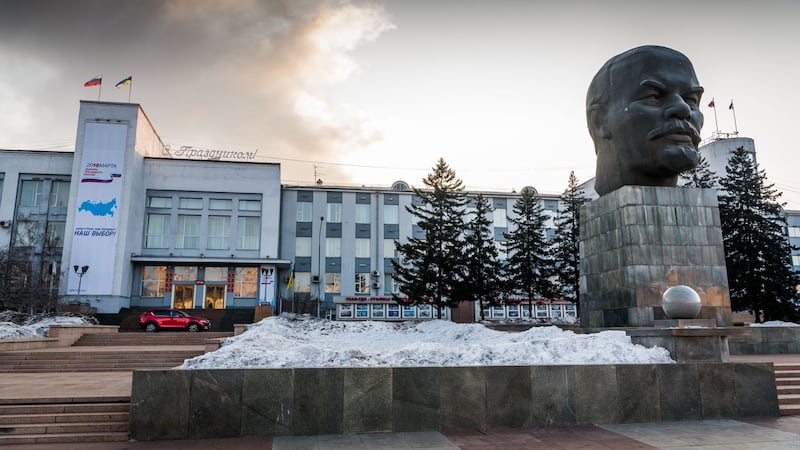
Steam clean
The CX-5 has held up surprisingly well, although one accompanying CX-9 seems to have become a two-wheel drive due to the bangs and thuds of bottoming out on the ice.
The only problem with our car is that at over 100km/h the ice still clinging to the car’s suspension and underfloor causes it to shudder violently. It’s as if it’s suffering post-traumatic stress disorder from what it has just been through. The only answer is a steam clean.
For us, the answer is dinner. On the second floor of what seems like a nondescript office block – and across the road from Ulan Ude’s Irish pub Harat’s – is Orda.
The restaurant’s soundtrack flickers from clearly Asian folk songs to throaty Russian marches. The food mix proves that fusion cuisine is not just a fashion fad from pretentious chefs; it is a reflection of the culture clashes at play in many people’s lives.
In its own way the current crop of crossovers, part hatchback, part people carrier, part SUV, a craze that gives life to cars like the Mazda CX-5, reflects a similar fusion of motoring cultures.
As for Baikal, it is best left to the likes of Alex and the omul fish. The lake is a serenely beautiful aquatic giant on the route from east to west. You’re better to take the highway, though.

























